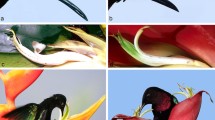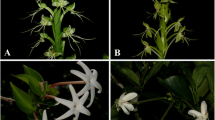Abstract
Distyly has been interpreted as a mechanism that promotes cross-pollination between floral morphs. According to this hypothesis, pollen from anthers positioned at different heights could adhere to different body parts of the pollinator that would correspond to those points where stigmas of compatible morph contact the animal. In this regard, hummingbird species with different bill sizes may play different roles as pollinators of each morph. If pollinators mobilize more legitimate pollen towards one of the two morphs, gender specialization may occur. This work aimed to assess experimentally the role of long- and short-billed hummingbirds as pollinators of short-style (SS) and long-style (LS) flowers of Palicourea demissa, a distylous, hummingbird-pollinated treelet in Venezuelan cloud forests. Flowers were emasculated and exposed to a single visit of the hummingbird Coeligena torquata (long-billed), Heliangelus spencei (short-billed) or Adelomyia melanogenys (short-billed). Later, stigmas were removed, and pollen load counted under a microscope to calculate the probability of legitimate- and illegitimate-pollen transfer by hummingbirds. The probability analyses of pollen transference showed that short-billed hummingbirds have higher pollination probabilities from SS-anthers to LS- and SS-stigmas, and from LS-anther to LS-stigmas than from LS-anther to SS-stigmas. In contrast, long-billed hummingbirds have higher probabilities of pollen transference from LS-anthers to SS-stigmas than in other directions. A deeper view of the sexual expression of each morph in P. demissa will depend on future studies that determine possible morpho-differences in the biological function of male and female floral structures, and the role played by less frequent floral visitors as mediators of legitimate pollination between floral morphs.




Similar content being viewed by others
References
Ataroff M, Rada F (2000) Deforestation impact on water dynamic in a venezuelan andean cloud forest. Ambio 29:440–444. https://doi.org/10.1579/0044-7447-29.7.440
Ataroff M, Sarmiento L (2004) Las unidades ecológicas de los Andes de Venezuela. In: La Marca E, Soriano PJ (eds) Reptiles de los Andes de Venezuela. Litorama, Mérida, Venezuela, pp 10–26
Barrett SCH (1990) The evolution and adaptive significance of heterostyly. Trends Ecol Evol 5:144–148. https://doi.org/10.1016/0169-5347(90)90220-8
Barrett SCH (1992) Heterostylous genetic polymorphisms: model systems for evolutionary analysis. In: Barrett SCH (ed) Evolution and function of heterostyly. Springer-Verlag, Berlin Heidelberg, New York, pp 1–29
Barrett SCH (2002) The evolution of plant sexual diversity. Nat Genet 3:274–284. https://doi.org/10.1038/nrg776
Barrett SCH, Richards JH (1990) Heterostyly in tropical plants. Mem NY Bot Gard 55:35–65
Barrett SCH, Jesson LK, Baker AM (2000) The evolution and function of stylar polymorphisms in flowering plants. Ann Bot 85:253–265. https://doi.org/10.1006/anbo.1999.1067
Beach JH, Bawa KS (1980) Role of pollinators in the evolution of dioecy from distyly. Evolution 34:1138–1142. https://doi.org/10.2307/2408294
Bergamo PJ, Wolowski M, Telles FJ, De Brito VLG, Varassin IG, Sazima M (2019) Bracts and long-tube flowers of hummingbird-pollinated plants are conspicuous to hummingbirds but not to bees. Biol J Linnean Soc 126:533–544. https://doi.org/10.1093/biolinnean/bly217
Cardoso JCF, Trevizan R, Matallana-Puerto CA, Gonçalves RV, Oliveira PE, Coelho CP, Matias R (2022) Do distylous syntopic plant species partition their floral morphological traits? Biol J Linnean Soc 137:54–67. https://doi.org/10.1093/biolinnean/blac072
Darwin C (1877) The different forms of flowers on plants of the same species. John Murray, London, p 284. https://doi.org/10.4324/9781315476452
De Castro CC, Araujo AC (2004) Distyly and sequential pollinators of Psychotria nuda (Rubiaceae) in the Atlantic rain forest, Brazil. Plant Syst Evol 244:131–139. https://doi.org/10.1007/s00606-003-0036-8
De Jong TJ, Klinkhamer PGL (2005) Evolutionary ecology of plant reproductive strategies. Cambridge University Press, Cambridge
Duan T, Deng X, Chen S, Luo Z, Zhao Z, Tu T et al (2018) Evolution of sexual systems and growth habit in Mussaenda (Rubiaceae): insights into the evolutionary pathways of dioecy. Mol Phylogenet Evol 123:113–122. https://doi.org/10.1016/j.ympev.2018.02.015
Dulberger R (1992) Floral polymorphisms and their functional significance in the heterostylous syndrome. In: Barrett SCH (ed) Evolution and function of heterostyly. Springer-Verlag, Berlin Heidelberg, New York, pp 41–84
Engel EC, Irwin RE (2003) Linking pollinator visitation rate and pollen receipt. Am J Bot 90:1612–1618. https://doi.org/10.3732/ajb.90.11.1612
Feinsinger P, Busby WH (1987) Pollen carryover: experimental comparisons between morphs of Palicourea lasiorrachis (Rubiaceae), a distylous, bird-pollinated, tropical treelet. Oecologia 73:231–235. https://doi.org/10.1007/BF00377512
Furtado MT, Matias R, Pérez-Barrales R, Consolaro H (2021) Do reciprocal herkogamy and pollinators affect legitimate pollen flow in distylous species of Rubiaceae? Bot J Linnean Soc 196:524–539. https://doi.org/10.1093/botlinnean/boab004
Ganguly S, Barua D (2021) Inter-morph pollen flow and reproductive success in a self‐compatible species with stigma‐height dimorphism: the influence of herkogamy and reciprocity. Plant Biol 23:939–946. https://doi.org/10.1111/plb.13308
García-Robledo C (2008) Asymmetry in pollen flow promotes gender specialization in morphs of the distylous neotropical herb Arcytophyllum lavarum (Rubiaceae). Evol Ecol 22:743–755. https://doi.org/10.1007/s10682-007-9198-0
González C, Ornelas JF, Jiménez L (2005) Between-year changes in functional gender expression of Palicourea padifolia (Rubiaceae), a distylous, hummingbird-pollinated shrub. Ann Bot 95:371–378. https://doi.org/10.1093/aob/mci026
Hernández A, Ornelas JF (2007) Disassortative pollen transfer in distylous Palicourea padifolia (Rubiaceae), a hummingbird-pollinated shrub. Ecoscience 14:8–16. https://doi.org/10.2980/1195-6860(2007)14[8:DPTIDP]2.0.CO;2
Hicks DJ, Wyat TR, Meagher TR (1985) Reproductive biology of distylous partridgeberry Mitchella repens. Am J Bot 72:1503–1514. https://doi.org/10.1002/j.1537-2197.1985.tb08413.x
Kearns CA, Inouye DW (1993) Techniques for pollination biologists. University Press of Colorado, Niwot, Colorado
Keller B, Thomson JD, Conti E (2014) Heterostyly promotes disassortative pollination and reduces sexual interference in Darwin’s primroses: evidence from experimental studies. Funct Ecol 28:1413–1425. https://doi.org/10.1111/1365-2435.12274
Lau P, Bosque C (2003) Pollen flow in the distylous Palicourea fendleri (Rubiaceae): an experimental test of the disassortative pollen flow hypothesis. Oecologia 135:593–600. https://doi.org/10.1007/s00442-003-1216-5
Liu Y, Luo Z, Wu X, Bai X, Zhang D (2012) Functional dioecy in Morinda parvifolia (Rubiaceae), a species with stigma-height dimorphism. Plant Syst Evol 298:775–785. https://doi.org/10.1007/s00606-011-0588-y
Lloyd DG, Webb CJ (1992) The selection of heterostyly. In: Barrett SCH (ed) Evolution and function of heterostyly. Springer-Verlag, Berlin Heidelberg, New York, pp 179–207
Machado ADO, Silva AP, Consolaro H, Barros MAG, Oliveira PE (2010) Breeding biology and distyly in Palicourea rigida H. B & K. (Rubiaceae) in the Cerrados of Central Brazil. Acta Bot Brasilica 24:686–696. https://doi.org/10.1590/S0102-33062010000300012
Maruyama PK, Justino DG, Oliveira PE (2016) Does intraspecific behavioural variation of pollinator species influence pollination? A quantitative study with hummingbirds and a neotropical shrub. Plant Biol 18:913–919. https://doi.org/10.1111/plb.12492
Morales I, Lara C, Castillo-Guevara C (2012) Transporte diferencial de polen por colibríes en una planta diestílica: no es lo mismo picos cortos que largos. Huitzil 13:74–86
Murcia C, Feinsinger P (1996) Interspecific pollen loss by hummingbirds visiting flower mixtures: effects of floral architecture. Ecology 77:550–560. https://doi.org/10.2307/2265629
Naiki A, Kato M (1999) Pollination system and evolution of dioecy from distyly in Mussaenda parviflora (Rubiaceae). Plant Species Biol 14:217–227. https://doi.org/10.1046/j.1442-1984.1999.00021.x
Nishihiro J, Washitani I, Thomson JD, Thomson BA (2000) Patterns and consequences of stigma height variation in a natural population of a distylous plant, Primula sieboldii. Funct Ecol 14:502–512. https://doi.org/10.1046/j.1365-2435.2000.00449.x
Ornelas JF, Jiménez L, González C, Hernández A (2004a) Reproductive ecology of distylous Palicourea padifolia (Rubiaceae) in a tropical montane cloud forest. I. Hummingbirds’ effectiveness as pollen vectors. Am J Bot 91:1052–1060. https://doi.org/10.3732/ajb.91.7.1052
Ornelas JF, González C, Jiménez L, Lara C, Martínez AJ (2004b) Reproductive ecology of distylous Palicourea padifolia (Rubiaceae) in a tropical montane cloud forest. II. Attracting and rewarding mutualistic and antagonistic visitors. Am J Bot 91:1061–1069. https://doi.org/10.3732/ajb.91.7.1061
Ornelas JF, Márquez-Guzmán J, Pérez Pacheco M (2020) Pollen and anther development malfunction in distylous flowers of Palicourea padifolia (Rubiaceae). Bot Sci 98:554–569. https://doi.org/10.17129/botsci.2608
Pailler T, Humeau L, Figier J, Thompson JD (1998) Reproductive trait variation in the functionally dioecious and morphologically heterostylous island endemic Chassalia corallioides (Rubiaceae). Biol J Linnean Soc 64:297–313. https://doi.org/10.1111/j.1095-8312.1998.tb00335.x
Pinheiro J, Bates D, DebRoy S, Sarkar D, Heisterkamp S, Van Willigen B (2018) Linear and Nonlinear Mixed Effects Models. Recuperado de: https://cran.rproject.org/web/packages/nlme/nlme.pdf
R Core Team (2021) R: a language and environment for statistical computing. R Foundation for Statistical Computing, Vienna, Austria. http://www.R-project.org/ Accessed 15 Oct 2021
Raupp PP, Matias R, Furtado MT, Consolaro H (2020) The role of distyly in pollen flow of the hummingbird-pollinated Palicourea rigida (Rubiaceae). Flora 271:151681. https://doi.org/10.1016/j.flora.2020.151681
Rengifo C, Nava A, Zambrano M (2005) Lista de aves de la mucuy y Mucubaji, Parque Nacional Sierra Nevada, Mérida-Venezuela. Serie Aves de Mérida, Mérida, Venezuela
Richards JH, Barrett SCH (1992) The development of heterostyly. In: Barrett SCH (ed) Evolution and function of heterostyly. Springer-Verlag, Berlin Heidelberg, New York, pp 85–227
Stone JL (1995) Pollen donation patterns in a tropical distylous shrub (Psychotria suerrensis; Rubiaceae). Am J Bot 82:1390–1398. https://doi.org/10.1002/j.1537-2197.1995.tb12675.x
Trevizan R, Cardoso JCF, Coelho CP, Consolaro H, Furtado MT, Oliveira PE (2021) Inaccuracy patterns and precise pollination among distylous Palicourea and Psychotria (Rubiaceae). Perspect Plant Ecol Evol Syst 53:125645. https://doi.org/10.1016/j.ppees.2021.125645
Valois-Cuesta H, Novoa-Sheppard S (2006) Ecología reproductiva de Palicourea demissa (Rubiaceae): néctar y colibríes en una selva nublada de Los Andes venezolanos. Rev Inst Univ Tec Chocó 25:40–46
Valois-Cuesta H, Soriano PJ, Ornelas JF (2011a) Dimorphisms and self-incompatibility in the distylous species Palicourea demissa (Rubiaceae): possible implications for its reproductive success. J Plant Res 124:137–146. https://doi.org/10.1007/s10265-010-0359-9
Valois-Cuesta H, Soriano PJ, Ornelas JF (2011b) Asymmetrical legitimate pollination in distylous Palicourea demissa (Rubiaceae): the role of nectar production and pollinator visitation. J Trop Ecol 27:393–404. https://doi.org/10.1017/S0266467411000150
Valois-Cuesta H, Soriano PJ, Ornelas JF (2012) Gender specialization in Palicourea demissa (Rubiaceae), a distylous, hummingbird-pollinated treelet. Plant Syst Evol 298:975–984. https://doi.org/10.1007/s00606-012-0607-7
Watanabe K, Shimizu A, Sugawara T (2014) Dioecy derived from distyly and pollination in Psychotria rubra (Rubiaceae) occurring in the Ryukyu Islands, Japan. Plant Species Biol 29:181–191. https://doi.org/10.1111/1442-1984.12013
Wolfe LM, Barrett SCH (1989) Patterns of pollen removal and deposition in tristylous Pontederia cordata (Pontederiaceae). Biol J Linnean Soc 36:317–329. https://doi.org/10.1111/j.1095-8312.1989.tb00498.x
Acknowledgements
We thank C Rengifo, JH Castaño, J Murillo, ME Naranjo, J Estrada, C García, FU Ely, N Ramírez, C Martínez-Ruiz and two anonymous reviewers for their valuable comments. This research was supported by the Red Latinoamericana de Botánica (Code: RLB06-M03 and RLB08-SP-1) and the Consejo de Desarrollo Científico, Humanístico y Tecnológico, Universidad de Los Andes, Mérida-Venezuela (Code: C-1557-08-01EM). Staff from the Estación Ornitológica La Mucuy, Parque Nacional Sierra Nevada, and the Laboratorio de Ecología Animal ‘‘A’’ of the Universidad de Los Andes, Mérida-Venezuela provided logistical support.
Author information
Authors and Affiliations
Contributions
Study conception and design: ZB, HVC, PJS; acquisition of data: ZB, HVC, PJS; analysis and interpretation of data: ZB, HVC; drafting of manuscript: ZB, HVC, PJS; critical revision and final version: ZB, HVC, PJS.
Corresponding author
Ethics declarations
Conflict of interest
The authors declare have no conflicts of interest.
Additional information
Publisher’s Note
Springer Nature remains neutral with regard to jurisdictional claims in published maps and institutional affiliations.
Rights and permissions
Springer Nature or its licensor (e.g. a society or other partner) holds exclusive rights to this article under a publishing agreement with the author(s) or other rightsholder(s); author self-archiving of the accepted manuscript version of this article is solely governed by the terms of such publishing agreement and applicable law.
About this article
Cite this article
Betancourt, Z., Soriano, P.J. & Valois-Cuesta, H. Long-and short-billed hummingbirds as pollinators of Palicourea demissa, a distylous treelet of Neotropical cloud forests. J Plant Res 136, 841–852 (2023). https://doi.org/10.1007/s10265-023-01492-2
Received:
Accepted:
Published:
Issue Date:
DOI: https://doi.org/10.1007/s10265-023-01492-2




